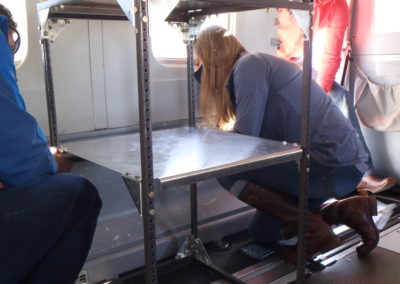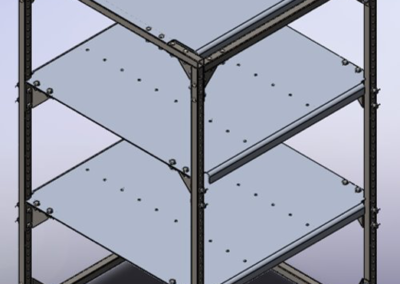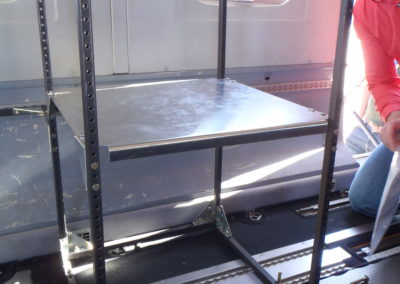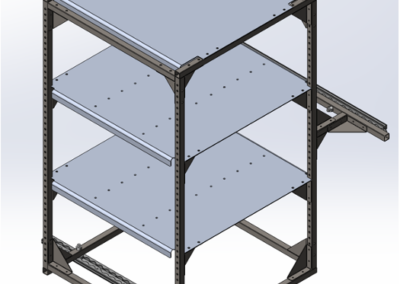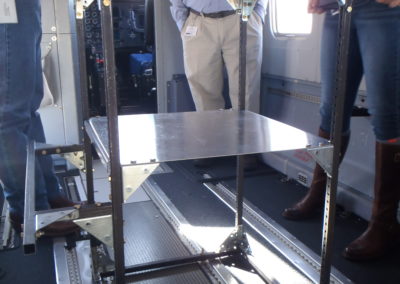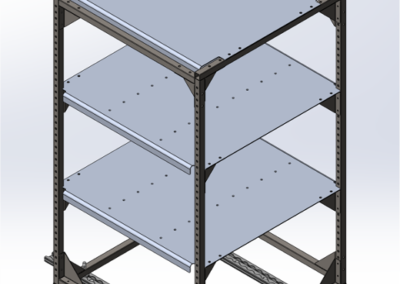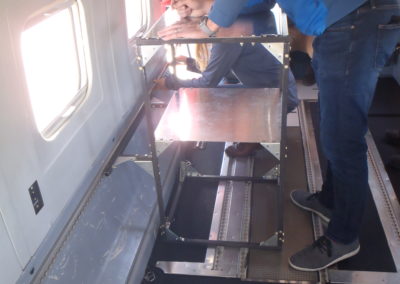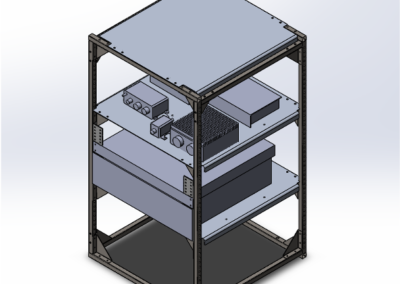Aircraft Modular Equipment Rack
Overview
Sierra Nevada Corporation (SNC) tasked our team to design an adjustable, modular equipment rack for integration into various Federal Air Regulation (FAR) Part 23 aircraft. This designation of aircraft includes the renowned Pilatus PC-12 and robust PZL M28. Differences between these aircraft added to the complexity of our solution through drastically different interface geometries.
Our design provides a unique, sleek solution to SNC defined and derived requirements which include vertical adjustability, withstanding 18g loadings, and minimizing weight. Standing just greater than 3 feet tall, our design, utilizes a 4130 square tube steel primary structure to withstand all loading conditions. In addition, 2024 sheet aluminum shelves support various critical components in countless configurations providing desired modularity. These readily available and cost-effective aircraft grade materials further validated our proof of concept through the creation of an aerospace ready prototype.
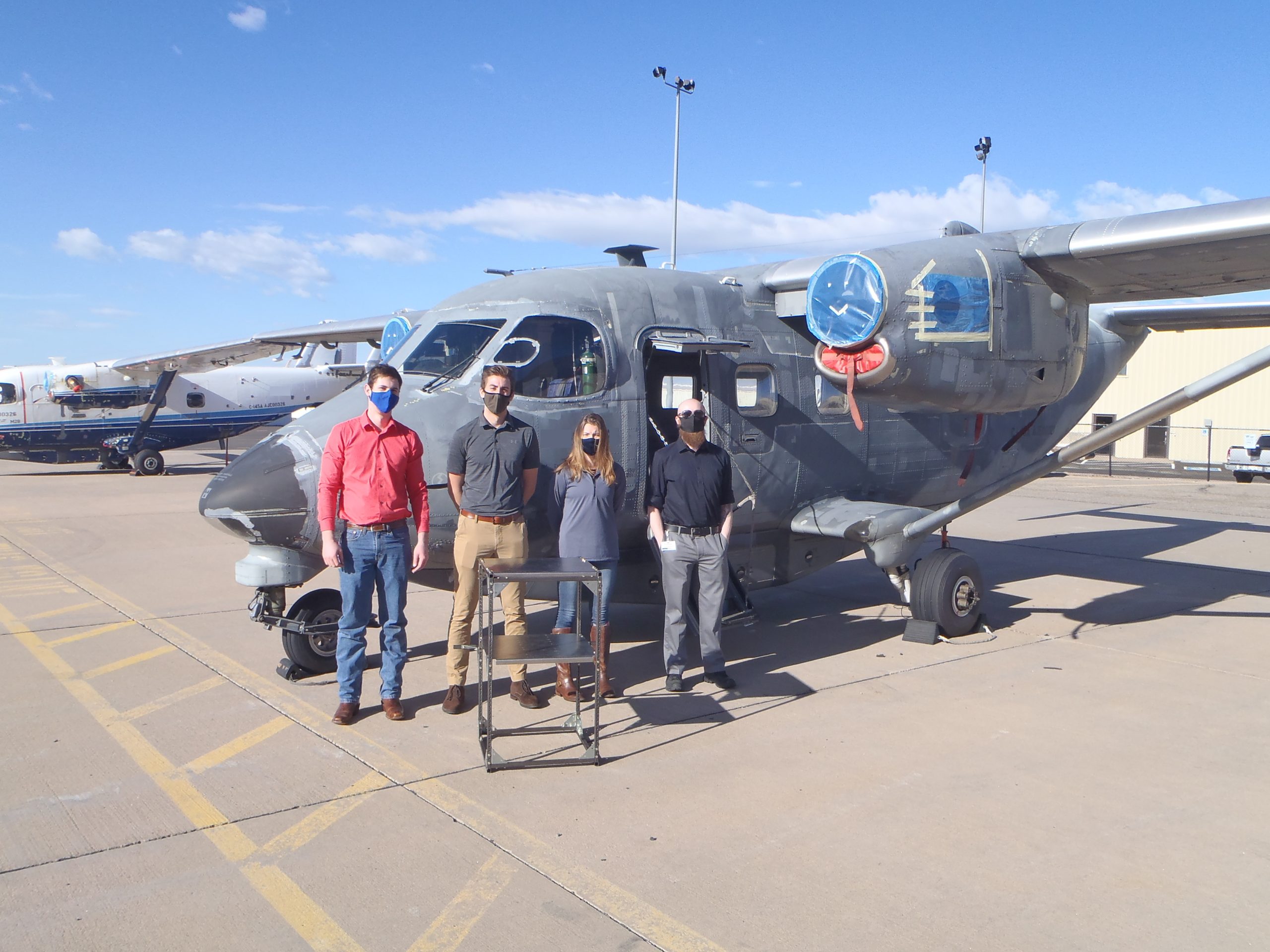
Live Zoom Chat
Use the link below to join us live from 8:00 – 10:30 a.m. on April 29.
Please use passcode: 354221
Or iPhone one-tap: 16699006833,99066801136# or 12532158782,99066801136#
Or Telephone:
Dial: +1 669 900 6833 (US Toll) or +1 253 215 8782 (US Toll)
Meeting ID: 990 6680 1136
Team Members
- Ernest Smith
- Connor Smith
- Tyler Cathcart-Joyce
- Noah Schroepfer
- Robert Pagano
- Ryan Wilson
- Hadley Bell
- Kylie Redding
The Client
- Andy Hardy
- Jared McPherson
- Chris Williamson
Sierra Nevada Corporation
Project Advisor
- Michael Yost
Acknowledgements
We would like to thank the staff of Sierra Nevada Corporations for sponsoring this project and allowing us to grow as engineers.
Special thanks are extended to Straight Flight Inc. for providing us access to industry materials, and fasteners for our prototype design.
Video
Elevator Pitch
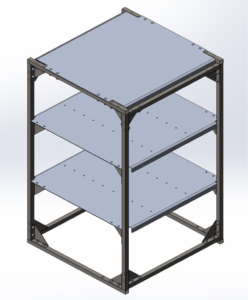 Equipment racks are used for a variety of applications in many industries. For our project, we we’re challenged to create a modular equipment rack suitable for Part 23 aircraft. Our team developed a unique design that not only can be adjusted to fit different aircraft, but be altered to fit different equipment as needed.
Equipment racks are used for a variety of applications in many industries. For our project, we we’re challenged to create a modular equipment rack suitable for Part 23 aircraft. Our team developed a unique design that not only can be adjusted to fit different aircraft, but be altered to fit different equipment as needed.
Design Approach
From the surface, an aviation rated equipment rack is deceptively simple; however, further research into design requirements quickly increased the complexity of the project. Currently, the Modular Equipment Rack meets requirements defined directly from SNC and requirements outlined by the Federal Aviation Administration. To reduce the complexity of this project, we utilized a proven design process used by SNC which follows the steps of scope definition, design iteration, and final design.
To begin, the first stage of the project, scope definition, began with determining project boundaries and compiling all design requirements. From this, a summary spreadsheet of 25 critical objectives was created, presented, and agreed upon. These objectives include multi-aircraft integration, meeting FAA design loads, and providing a step size of less than 1”. Additionally, the Pilatus PC-12 and PZL M28 were measured during this period to provide geometries to design from.
Setting assumptions followed to ensure the scope was further solidified. One of these assumptions was that the Modular Equipment Rack shelf adjustment will occur in the hangars, not mid-flight. Thus, allowing the team to select locking hardware and making design adjustments needed for this hardware.
The next stage of design iterations followed, with several sub-teams being formed for rapid design iterations based on critical analysis. Rapid design iterations were created to meet available materials, which were selected based on strength, weight, and availability. Analysis was then performed on these designs to ensure loading requirements were met. For several iterations, the design was unable to withstand FAA defined “crash loadings.” With guidance from SNC engineers, especially related to the complex analysis, the team was able to adjust the design to meet FAA loadings while meeting all other requirements.
Finally, a prototype was created to match the design, and hardware was purchased for aircraft integration. The team test fit a prototype Modular Equipment Rack into a PZL M28, validating the need for small interface adjustments. These adjustments will ensure the Modular Equipment Rack’s design was finalized and will successfully integrate to the specified aircraft. Shown in the image is the Modular Equipment Rack’s final design.


Design Solution
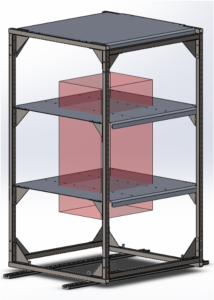 The design of the equipment rack provides an adaptable solution that can be implemented into any Part 23 aircraft with small alterations. As new equipment is needed in the aircraft, the shelves will be adjustable to accommodate the change in equipment by simply moving the shelves vertically with a 0.75” step size. The rack is easily accessible from all four sides, and maintains equipment protection with the structure cap.
The design of the equipment rack provides an adaptable solution that can be implemented into any Part 23 aircraft with small alterations. As new equipment is needed in the aircraft, the shelves will be adjustable to accommodate the change in equipment by simply moving the shelves vertically with a 0.75” step size. The rack is easily accessible from all four sides, and maintains equipment protection with the structure cap.
The vertical stanchions that would support most the load was selected to be 4130 Steel square tubing. The steel structure provides high strength to cost ratio, while the square tubing reduces the overall weight of the structure due to its small size.
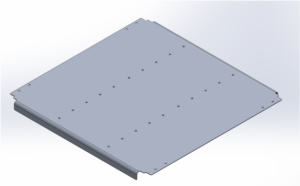 The structure maintains full rigidity through the square tubing, structure cap, and fasteners. The structural cap and shelves provide additional structural support to the rack. The shelves have through holes throughout the shelf for the equipment integration onto the rack. Additionally, the shelves and structure cap have bent edges and L-beams that span the length of the material to prevent deformation and to add rigidity.
The structure maintains full rigidity through the square tubing, structure cap, and fasteners. The structural cap and shelves provide additional structural support to the rack. The shelves have through holes throughout the shelf for the equipment integration onto the rack. Additionally, the shelves and structure cap have bent edges and L-beams that span the length of the material to prevent deformation and to add rigidity.
The body of the rack is secured by permanent HI-LOK® fasteners. AN4-12 bolts were used for the temporary fasteners that are removable on the shelves and gussets. The AN4-12 bolts are secure for the duration of flights but can be removed when shelves need to be adjusted on the ground.
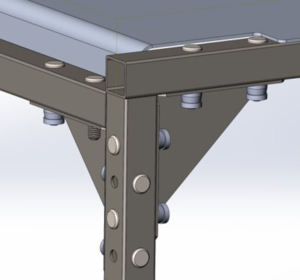 The modular equipment rack maintains a lightweight of 25.35 pounds without equipment. While steel is the material utilized for the stanchions and gussets, aluminum is used throughout the other parts of rack due to its high strength to weight ratio. The shelves and structure cap are designed from 2024 T3 Aluminum, which is a high strength aerospace grade alloy.
The modular equipment rack maintains a lightweight of 25.35 pounds without equipment. While steel is the material utilized for the stanchions and gussets, aluminum is used throughout the other parts of rack due to its high strength to weight ratio. The shelves and structure cap are designed from 2024 T3 Aluminum, which is a high strength aerospace grade alloy.
Ultimately, material selection was a key component for the success of the project and the verification of the rack. The structure meets all crash load requirements from the FAR Part 23 documentation and the client plans to take an iteration of the design to begin flight approval.
Next Steps
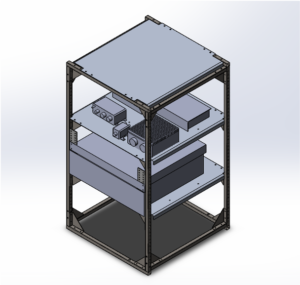 Comparing our design to other certified design, the Modular Equipment Rack has several advantages related to the design’s low profile, instrument access, and overall cost. However, there are several pathways which can be pursued to further improve the Modular Equipment Rack’s design. These include, continued weight reduction, reducing shelf step size to improve adjustability, and changing primary structure materials. Additionally, full certification can be pursued with the FAA allowing the Modular Equipment Rack to be approved for use in the Pilatus PC-12 and PZL M28. Finally, additional design and analysis can be performed to allow the Modular Equipment Rack to integrate into more FAR Part 23 aircraft platforms.
Comparing our design to other certified design, the Modular Equipment Rack has several advantages related to the design’s low profile, instrument access, and overall cost. However, there are several pathways which can be pursued to further improve the Modular Equipment Rack’s design. These include, continued weight reduction, reducing shelf step size to improve adjustability, and changing primary structure materials. Additionally, full certification can be pursued with the FAA allowing the Modular Equipment Rack to be approved for use in the Pilatus PC-12 and PZL M28. Finally, additional design and analysis can be performed to allow the Modular Equipment Rack to integrate into more FAR Part 23 aircraft platforms.
Meet the Team
Ernest Smith
 Ernie Smith is a graduating senior in Mechanical Engineering with a minor in Economics. Ernie worked as the Communications Lead throughout the course of this project. Ernie’s interests include 4-wheeling, camping, and skiing. After graduation, Ernie will be working as an engineer at Sierra Nevada Corporation and continue to grow his engineering skills.
Ernie Smith is a graduating senior in Mechanical Engineering with a minor in Economics. Ernie worked as the Communications Lead throughout the course of this project. Ernie’s interests include 4-wheeling, camping, and skiing. After graduation, Ernie will be working as an engineer at Sierra Nevada Corporation and continue to grow his engineering skills.
Connor Smith
 Connor Smith is a graduating Senior in Mechanical Engineering with a minor in Public Affairs. Connor worked as the systems team Lead and apart of the stress team. Connor spends his free time working on various DIY projects, cooking, and exercise! After graduation, Connor will be working as a Lab Technician for DARPA’s underground tunneling research before entering the workforce in the fall.
Connor Smith is a graduating Senior in Mechanical Engineering with a minor in Public Affairs. Connor worked as the systems team Lead and apart of the stress team. Connor spends his free time working on various DIY projects, cooking, and exercise! After graduation, Connor will be working as a Lab Technician for DARPA’s underground tunneling research before entering the workforce in the fall.
Kylie Redding
 Kylie Redding is a graduating senior in Mechanical Engineering. Kylie worked as the Design Team lead for the project. Texas born and raised, but loves being in the mountains. When Kylie is not practicing or playing with the Mines Softball team, she enjoys hiking, mountain biking, and going on new adventures. Following graduation in May, Kylie will join ARCO/Murray as a project manager.
Kylie Redding is a graduating senior in Mechanical Engineering. Kylie worked as the Design Team lead for the project. Texas born and raised, but loves being in the mountains. When Kylie is not practicing or playing with the Mines Softball team, she enjoys hiking, mountain biking, and going on new adventures. Following graduation in May, Kylie will join ARCO/Murray as a project manager.
Noah Schroepfer
 Noah Schroepfer is a graduating senior in Mechanical Engineering. He worked as the stress team lead for the project sponsored by SNC. As the stress team lead, he helped delegate tasks, performed calculations to see if the rack could withstand emergency crash loads, and organized everyone’s work. Noah’s interests include running, basketball, and walking his dogs. After graduating this semester, he will move to Missouri to be a manufacturing engineer at Kemco Aerospace Manufacturing.
Noah Schroepfer is a graduating senior in Mechanical Engineering. He worked as the stress team lead for the project sponsored by SNC. As the stress team lead, he helped delegate tasks, performed calculations to see if the rack could withstand emergency crash loads, and organized everyone’s work. Noah’s interests include running, basketball, and walking his dogs. After graduating this semester, he will move to Missouri to be a manufacturing engineer at Kemco Aerospace Manufacturing.
Ryan Wilson
 My name is Ryan Wilson, and I am currently a senior at Colorado School of Mines graduating with a B.S in Mechanical Engineering and a minor in Economics. I grew up in Evergreen Colorado and followed the footsteps of my two older sisters who also graduated from Mines, both with Mechanical Engineering degrees. While being at Mines, I have played for the Varsity Men’s Soccer for all four years. Outside of school and soccer, my favorite hobbies are golf, wakeboarding, and skiing. Once graduated, I will be working for Baker Hughes in their ASPIRE Sales and Commercial Development Program based out of Houston Texas!
My name is Ryan Wilson, and I am currently a senior at Colorado School of Mines graduating with a B.S in Mechanical Engineering and a minor in Economics. I grew up in Evergreen Colorado and followed the footsteps of my two older sisters who also graduated from Mines, both with Mechanical Engineering degrees. While being at Mines, I have played for the Varsity Men’s Soccer for all four years. Outside of school and soccer, my favorite hobbies are golf, wakeboarding, and skiing. Once graduated, I will be working for Baker Hughes in their ASPIRE Sales and Commercial Development Program based out of Houston Texas!
Robert Pagano
 Robert Pagano is a graduating senior in Mechanical Engineering. He served on the stress team, responsible for analyzing the structure of the rack to ensure it did not fail under crash loadings. His interests include hiking, climbing, and winter sports. After graduating, he will intern with Northrop Grumman during the summer, and then return to finish a Master’s in Mechanical Engineering at Mines.
Robert Pagano is a graduating senior in Mechanical Engineering. He served on the stress team, responsible for analyzing the structure of the rack to ensure it did not fail under crash loadings. His interests include hiking, climbing, and winter sports. After graduating, he will intern with Northrop Grumman during the summer, and then return to finish a Master’s in Mechanical Engineering at Mines.
Tyler Cathcart-Joyce
 Tyler Cathcart-Joyce is a graduating senior in Mechanical Engineering. Tyler served on the design team for the project. Tyler’s interests include woodworking, home improvement projects, table-top RPGs, gaming with friends, and walking his dog. After graduating this semester, Tyler will be taking a brief hiatus to help his family with some home repairs and improvements, before joining the workforce.
Tyler Cathcart-Joyce is a graduating senior in Mechanical Engineering. Tyler served on the design team for the project. Tyler’s interests include woodworking, home improvement projects, table-top RPGs, gaming with friends, and walking his dog. After graduating this semester, Tyler will be taking a brief hiatus to help his family with some home repairs and improvements, before joining the workforce.
Hadley Bell
 Hadley Bell is a senior in Mechanical Engineering and Computer science, graduating December 2021. Hadley worked as part of the systems and design teams during the project. She competes as a multi-sport athlete in Mines Cross country and Track and Field. Hadley will intern for Ford as a Project Engineer in training over the summer. She will return to school for her last semester before beginning the Mechanical Engineering Master’s program.
Hadley Bell is a senior in Mechanical Engineering and Computer science, graduating December 2021. Hadley worked as part of the systems and design teams during the project. She competes as a multi-sport athlete in Mines Cross country and Track and Field. Hadley will intern for Ford as a Project Engineer in training over the summer. She will return to school for her last semester before beginning the Mechanical Engineering Master’s program.

